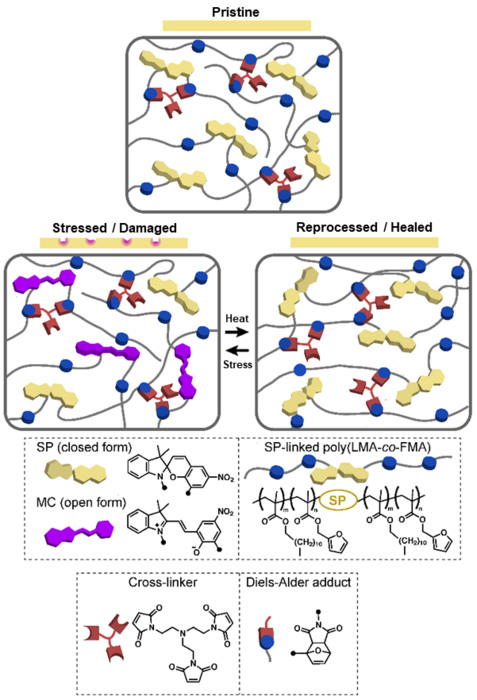Polymeric coverings resembling skin are placed on the exterior surfaces of vehicles, ships, and buildings to shield them from the environment.
 Schematic of mechanochromic and self-healing thermosets. Image Credit: Korea Institute of Science and Technology (KIST)
Schematic of mechanochromic and self-healing thermosets. Image Credit: Korea Institute of Science and Technology (KIST)
Due to the difficulty in determining whether the recently applied coatings are already damaged, these non-recyclable coatings must be renewed frequently, resulting in significant waste generation and high disposal costs.
The Korea Institute of Science and Technology announced that Dr Tae Ann Kim’s group at the Soft Hybrid Materials Research Center has created a polymeric coating that changes color when damaged, allowing quick detection and high-temperature self-healing.
Currently conducted research on damage-reporting and self-healing polymeric coatings involves incredibly tiny capsules that contain functional chemicals. However, if shattered, these capsules are useless for further damage detection and self-healing.
The KIST research team has created a thermoset polymer that can self-report damage and self-heal several times by returning to its original chemical structure after being disturbed by external stimulation.
A thermoset polymer comprising a molecule that can be split apart and reassembled by temperature was created in this study, as well as a mechanochromic molecule, which changes color when an external force is applied due to a particular bond cleavage.
A mechanochromic molecule breaks a specific connection when a force is applied, transforming into a form that can display color.
The synthetic polymeric coating’s damaged region took on a purple hue. The material became processable, physically healed, and colorless when a temperature of 100 °C or higher was applied.
The functionality was achieved by synthesizing the actual coating agent, but the study team used molecular dynamics simulations to predict and demonstrate that only specific desirable chemical bonds are selectively broken when a mechanical force is applied to create a colorful structure.
The inventive multifunctional polymeric coating created here has a wide range of applications in the railroad, highway, aviation, automobile, marine, and defense industries. It can also significantly reduce industrial waste.
Since it functions similarly to skin and does not need an external energy source, it can be used as an artificial skin for robots such as humanoids.
This study reports a method for the simultaneous realization of damage detection and self-healing technology without any external agents such as capsules. However, even if repeated self-healing is possible, it cannot be used permanently. Therefore, additional research is underway to transition materials that have reached their lifespan into materials that are harmless to the environment or convert them into a re-cyclable form.
Dr Tae Ann Kim, Soft Hybrid Materials Research Center, Korea Institute of Science and Technology
The Ministry of Science and ICT (Minister Jong-Ho Lee) provided funding for this study, which was carried out as part of the KIST institutional program (K-Lab).
Journal Reference:
Yoon, S., et al. (2022) Mechanochromic and thermally reprocessable thermosets for autonomic damage reporting and self-healing coatings. NPG Asia Materials. doi:10.1038/s41427-022-00406-3